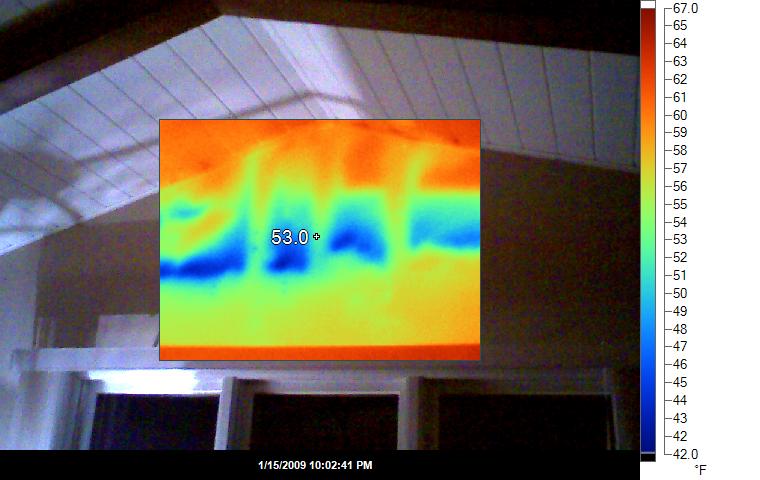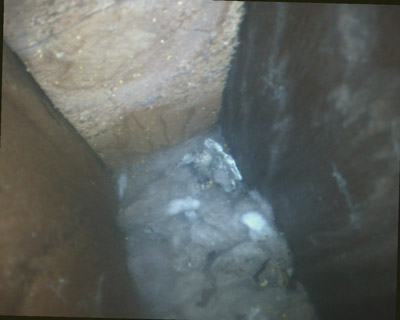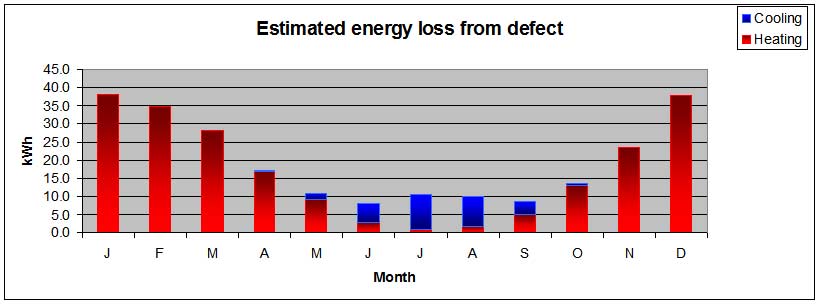- Home
- Deceptions
- Solar
- Thermal Audit
- Ventilation
- Sensors
- Governance
- Environment
- Reference
- Contact
- News
Infrared Imaging of Missing Insulation
It is very likely that you have cold spots in your walls due to insulation settling (especially the blown-in fluffy types, like cellulose) and sloppy workmanship. You can identify this by putting your hand on the walls and feeling for cold sections or using an infrared thermometer and scanning the inside of exterior walls looking for lower readings. The ideal method is to hire a thermal auditor to perform an infrared scan.

In the picture above, we are inside of a heated room looking at an exterior wall. The blue spots are areas where the insulation appears to be missing. The darkest blue areas are in the mid 40s, which is about 20 degrees colder than the warm areas. You should be able to feel around using your hands and find spots like this yourself and drill an inspection hole if you like, to verify what is going on. Later you can use the hole to fill the cavity with insulation foam. The colors in the infrared photo are fake -- heat has no color, however red for warmer and blue for colder does make it easy to understand.
The picture below shows the void inside the wall above. You are looking through a hole in the wall with an inspection scope that is pointed straight down. The light wood section is a vertical wall stud (2x4). Although it is conceivable that the insulation settled, it is more likely that this section of the wall was never filled.

The rate at which heat is lost is proportional to the difference between the inside and outside temperatures. When this picture was taken, it was very cold outside (about 12°F or -11°C).
You can calculate what a similar, poorly insulated spot in your house is costing you as follows:
Calculate the R value of the regular wall. You do this by adding up the R-values of the individual components such as siding, plaster drywall, plywood etc. R-values are additive, just like resistors are when you work with electronics. Use a source like ColoradoEnergy.org to calculate the R-value of your wall. The difference in R-value between the section of wall with insulation and the sections that are cold is simply the value of the missing, standard 3.5" insulation (assuming you have 2 inch x 4 inch wooden studs, or 2x4's as they are often called, in the walls).
Also note that the wooden studs are fairly good insulators. You can see their yellow sillouettes against the blue coldness of the insulation voids in the photo above. The thick wooden walls of log cabins are actually good insulators provided you can plug the air gaps between the logs.
Next calculate the surface area of the cool spots. If it is rectangular in shape, this is simply the length times the height. You probably won't find many circular or triangular cold spots so you won't need to remember your geometry equations. In the photo above, the close area is about 1 square meter.
The equation below shows the relationship between the RSI value and the power loss in watts through a wall.

We are using metric measurements here. RSI is just the metric R value, °K is the same as Celsius except for the location of zero on the scale, and m is meters. You can use the obsolete british units, but it is easier to make mistakes. Multiply R values (Like R-12 fiberglass insulation by 0.176 to get the RSI value). Most new insulation has both the R and RSI values on the label.
Next, collect your heating and cooling degree days from some site like degreedays.net. The closest airport is usually good enough.
So for example, say you ended up with the following:
January degree days last year at an airport near you: 956 (metric units)
Surface area of cold spot: 1 m2 (square meter)
RSI of insulated wall: 2.4 (metric R value)
RSI of wall without insulation: 0.5
Outside Temperature: -12°C
Inside Temperature: +18°C
Temperature delta: 30°C or 30°K
Then we can calculate the heat transfer for an insulated section and subtract the heat transfer for the bad section. The difference is your rate of loss:

or with the figures for the cold spot for the month of January,

You can than change the RSI (insulation value) of 0.5 to 2.4 in the equation above to calculate what an insulated section would have lost. The difference is what you are unnecessarily losing because of the defect.
Here we are using the degree days to make it look like one bad day in January where the temperature difference was 956°K (not possible of course) for 24 hours rather than 30 days with smaller differences. The final result is the same, so this makes the math easier.
You should get a difference of 38kWh between the defective area and the same size area with insulation. This means that the the section with the missing insulation lost 38kWh more energy than it would have, if it was properly insulated. Energy is usually measured in Joules, but we are using kWh (1 kWh = a 1000 Watt hair dryer for one hour) here instead because electricity rates are based on this unit and familiar to most people, and if you move the decimal point, you get dollars. For example, 38 kWh costs $3.80 when power costs 10 cents per kWh which is typical in North America.
At 10 cents per kWh for electric heat, this is $3.80 in losses for January that would not have happened if the insulation was installed properly. Natural gas costs about half this. If natural gas is available in your area and you use electric heat, consider switching.
If you do this calculation for the whole year, for both cooling and heating, you will be able to calculate the energy loss due to the insulation defect in your climate. When you calculate cooling, use cooling degree days and divide the electric rate by three because most air conditioners have an co-efficient of performance of about 3. For every watt of electric power, they pump out about three watts of heat.
With a monetary value on your defects, you are in a good position to figure out much it is worth spending to fix it. You might also consider getting an IR scan done on a house you plan to purchase so that you can get the the cost of the repairs deducted from the price. In our links section there is a study from Louisiana that shows that even expensive homes are full of thermal defects due to sloppy workmanship, made worse by the fact that the problem is invisible and builders know they can get away with it.
Also note that even if the cold spot only costs you three dollars a month in the winter, if it is located somewhere like a bathroom (that is always too cold and you don't like frozen toilet seats) or behind a sofa at neck level, and you end up turning up the central heat or using a space heater to compensate, it could be costing you much more. If the vapor barrier is missing along with the insulation (often the case with sloppy workmanship), you may be getting condensation in your wall and growing mold and making your allergies worse.
Here is what the losses look like over the year. In the month of June, heat is being lost on cold nights and cold is being lost on hot days.

-- end --
